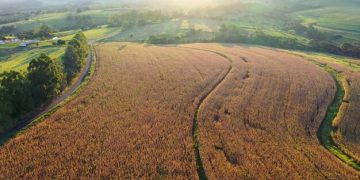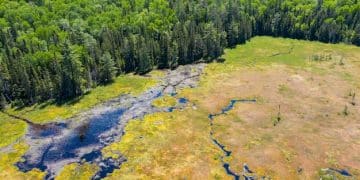Act Now: Federal Grants for Environmental Conservation Projects

The federal government offers time-sensitive grants for environmental conservation projects, providing crucial funding opportunities for organizations and individuals dedicated to protecting and restoring natural resources, but understanding the application process and deadlines is paramount for success.
Time-Sensitive: Act Now – How to Apply for the Limited-Time Federal Grants for Environmental Conservation Projects. The window for securing vital funding to protect our planet is often brief and demanding. These federal grants represent not just financial support, but a critical opportunity for organizations, communities, and individuals to drive meaningful change in environmental conservation.
Understanding Federal Environmental Grants: A Landscape of Opportunity
Federal grants for environmental conservation projects are a cornerstone of national efforts to protect natural resources, mitigate climate change, and promote sustainable practices. These grants are not simply handouts; they are strategic investments made by the government to achieve specific environmental outcomes. Understanding the overarching goals and priorities behind these funding programs is the first step toward a successful application. The federal government, through various agencies, targets a broad spectrum of environmental issues, from biodiversity protection and ecosystem restoration to pollution reduction and sustainable development. Each grant program typically has a clearly defined scope, eligibility criteria, and expected outcomes, which applicants must meticulously review. Missing the nuances of these requirements can lead to an immediate disqualification, regardless of the project’s merit.
The Agencies Behind the Funding
Multiple federal agencies are involved in distributing environmental grants, each with its own focus and funding mechanisms.
- Environmental Protection Agency (EPA): Often focuses on pollution prevention, Superfund cleanups, tribal environmental programs, water quality, and air quality initiatives.
- Department of Agriculture (USDA): Primarily supports conservation efforts on agricultural lands, forest management, and rural development that links to environmental stewardship. Programs like the Natural Resources Conservation Service (NRCS) are pivotal here.
- Department of the Interior (DOI): Funds projects related to national parks, wildlife refuges, endangered species, water resources, and public lands management through agencies like the Fish and Wildlife Service and the National Park Service.
- National Oceanic and Atmospheric Administration (NOAA): Concentrates on coastal restoration, marine conservation, fisheries management, and climate research.
These agencies don’t just provide money; they often offer technical assistance and resources that can further strengthen a project’s impact. Engaging with program officers—when permitted and appropriate—can provide invaluable insights into the grant’s specific priorities and unofficial expectations. Such interactions can help fine-tune a project proposal to better align with the grant’s objectives, improving the chances of success. Furthermore, understanding the political and administrative context in which these grants are issued can offer a strategic advantage, allowing applicants to frame their proposals in alignment with current governmental priorities and pressing national environmental concerns.
The grant landscape is dynamic, with priorities shifting based on new legislation, scientific findings, and urgent environmental challenges. Staying updated on these trends is crucial for any potential applicant. Subscribing to agency newsletters, attending webinars, and monitoring federal registers are effective ways to keep abreast of opportunities. Crafting a proposal that resonates with current federal objectives not only increases its chances of funding but also demonstrates the applicant’s awareness and commitment to broader environmental goals.
Identifying the Right Grant for Your Project: Precision is Key
Navigating the multitude of federal grant opportunities can be daunting, but a systematic approach to identification is crucial for success. Not every environmental project is a fit for every grant, and misaligning your project with a grant’s objectives is a common pitfall. Start by clearly defining your project’s scope, goals, target beneficiaries, and geographical impact. What specific environmental problem are you addressing? What tangible outcomes do you expect? How will your project contribute to broader conservation efforts? Once you have a crystal-clear understanding of your project, you can begin the focused search for suitable funding.
The primary resource for discovering federal grants is Grants.gov, the centralized hub for all federal funding opportunities. This platform allows users to search by keyword, agency, and eligibility criteria, among other filters. Regularly checking Grants.gov for new postings and updates is essential, as grant announcements, amendments, and deadlines are frequently published there. Beyond Grants.gov, individual agency websites often provide more detailed breakdowns of their programs, past grant recipients, and specific program officer contacts. These agency-specific pages can offer richer context and guidance that may not be immediately apparent on the broader federal portal.
Matching Your Project to Grant Priorities
Successful grant acquisition hinges on a precise alignment between your project and the grant’s stated priorities.
- Review Official Grant Announcements: Carefully read the Notice of Funding Opportunity (NOFO) or Request for Applications (RFA). Pay close attention to the purpose, objectives, eligible activities, and evaluation criteria. These documents are your roadmap.
- Understand Agency Missions: Each federal agency has a distinct mission and strategic goals. Ensure your project naturally fits within the mission of the issuing agency. For instance, a marine conservation project is more likely to find a home at NOAA than at the USDA, unless it involves aquaculture or coastal agricultural practices.
- Examine Past Awards: Many agencies publish lists of previously funded projects. Analyzing these can provide valuable insights into the types of projects they prefer to fund, their typical award sizes, and the geographic distribution of their investments. This historical data can inform your proposal’s framing and scope.
It is important to resist the temptation to “force fit” your project into a grant program that is not a natural match. Grant reviewers are highly skilled professionals who can easily discern when a proposal has been shoehorned into an unsuitable category. Instead, invest time in identifying programs that genuinely align with your project’s core objectives and methodology. This not only increases your chances of securing funding but also ensures that your project will contribute meaningfully to the grant’s intended environmental impact. If a perfect grant doesn’t immediately appear, consider how your project might be modularized or adapted to fit a specific funding stream, without compromising its integrity.
Moreover, grants often specify particular geographic areas or demographic groups they aim to serve. For example, some grants might prioritize projects in underserved communities or those impacting areas designated as critical habitats. Being aware of these specific targeting factors can significantly narrow your search and highlight opportunities where your project has a competitive edge. This meticulous selection process is a crucial differentiator for applications that stand out in a highly competitive funding environment, ensuring that limited resources are directed towards projects with the highest potential for impact and alignment.
The Application Process: A Step-by-Step Guide to Success
The application process for federal environmental grants is typically rigorous, demanding meticulous attention to detail and adherence to strict guidelines. Approaching it systematically can drastically improve your chances of success. It begins long before you write the first word of your proposal. Early preparation involves gathering necessary organizational documents, such as tax identification numbers, registration details on federal procurement systems like SAM.gov (System for Award Management), and proof of eligibility. Without these foundational elements in place, your application cannot even proceed. Many grant opportunities also require applicants to register on Grants.gov, which can take several weeks to process, so starting this early is non-negotiable.
Once the logistical prerequisites are met, the focus shifts to crafting a compelling proposal. This means going beyond simply describing your project; it involves building a narrative that convinces reviewers your project is not only viable but essential. A clear understanding of the grant’s specific evaluation criteria, usually outlined in the NOFO, is paramount. These criteria often include project merit, technical approach, organizational capacity, budget realism, and potential for environmental impact. Each section of your proposal must directly address these criteria, providing evidence and justification for your claims. Reviewers use these criteria as a checklist, and failure to address any point adequately can be detrimental to your application’s score.
Key Components of a Strong Proposal
A well-structured proposal typically includes several critical sections that collectively tell the story of your project and its potential impact.
- Executive Summary: A concise, compelling overview of your entire proposal, often read first (and sometimes last) by reviewers. It should capture the essence of your project and its significance.
- Project Narrative: This is the core of your proposal, detailing the problem your project addresses, its objectives, methodologies, timeline, and expected outcomes. Clarity, coherence, and specificity are key here.
- Budget Justification: A detailed breakdown of all project costs, clearly linking each expense to project activities. All requested funds must be reasonable, allowable, and allocable.
- Organizational Capacity: Demonstrates your team’s expertise, past successes, and the resources available to successfully execute the project. Highlight relevant experience of key personnel.
- Evaluation Plan: Explains how you will measure your project’s progress and impact. This includes specific metrics, data collection methods, and reporting strategies.
Drafting the proposal often requires multiple iterations. It’s advisable to start early, allowing ample time for writing, reviewing, and refining. Engage colleagues, mentors, or external grant writers to review your drafts; fresh eyes can spot inaccuracies, ambiguities, or areas where the proposal could be strengthened. Pay particular attention to the language used, ensuring it is professional, clear, and persuasive, avoiding jargon where simpler terms suffice. The goal is to make your proposal easy to understand and compelling for a diverse review panel, some of whom may not be experts in your specific field but are looking for well-reasoned and impactful plans.
Finally, do not underestimate the importance of meticulous proofreading. Grammatical errors, typos, and formatting issues can distract reviewers and undermine the professionalism of your application. Before final submission, cross-reference your completed proposal against the NOFO’s checklist to ensure every requirement has been met. Missing a single required document or failing to follow a specific formatting instruction can lead to disqualification, regardless of the quality of your project itself. The federal grant application process is a test of both your project’s merit and your organization’s administrative capacity.
Crafting a Compelling Project Narrative: Telling Your Story Effectively
The project narrative is arguably the most critical section of your grant application; it’s where you tell your story and make a persuasive case for why your project deserves funding. This section moves beyond mere facts and figures, inviting reviewers into the vision, methodology, and ultimate impact of your work. It must be engaging, logical, and thoroughly convincing. Begin by clearly articulating the environmental problem your project aims to solve. This isn’t just stating a problem; it’s demonstrating its urgency, scale, and relevance to the grant’s priorities. Provide data, statistics, and credible references to underscore the significance of the issue. A well-defined problem statement lays a strong foundation for the solutions you propose.
Following the problem statement, introduce your project’s specific objectives. These should be S.M.A.R.T.: Specific, Measurable, Achievable, Relevant, and Time-bound. Vague objectives like “improve environmental health” are insufficient; instead, aim for something like “Restore 5 acres of riparian habitat along the Smith River, increasing native plant diversity by 30% within two years.” Each objective should clearly state what will be accomplished, by when, and how success will be measured. This precision demonstrates foresight and accountability, key attributes that funders seek. The narrative then expands into the detailed methodology, explaining step-by-step how these objectives will be realized.
Elements of a Powerful Narrative
An effective project narrative weaves together various components to create a cohesive and persuasive argument.
- Problem Statement: Clearly define the environmental issue, its causes, and its impacts. Use data and credible sources to support your claims.
- Goals and Objectives: State what your project aims to achieve (goals) and the specific, measurable steps you will take (objectives).
- Methodology/Activities: Describe the specific actions, processes, and techniques you will employ. Explain why these methods are effective and how they will lead to the desired outcomes.
- Expected Outcomes/Impact: Articulate the anticipated short-term and long-term results of your project. How will it benefit the environment, communities, and potentially contribute to broader conservation goals?
- Sustainability Plan: Explain how the project’s benefits will be sustained beyond the grant funding period. Will there be ongoing community involvement, alternative funding sources, or policy changes?
Beyond the structural elements, the narrative should convey a sense of passion and commitment. While maintaining a professional tone, infuse enough enthusiasm to show that your team is deeply invested in the project’s success. Use clear, concise language, avoiding technical jargon where possible, or defining it when necessary. Employing compelling examples and case studies can illustrate your points more vividly. For instance, if discussing a restoration technique, briefly mention a successful application of that technique from a past project. This not only builds credibility but also makes the narrative more engaging for the reviewer.
Crucially, the narrative must also address how your project aligns with the specific priorities of the grant program. This means explicitly drawing connections between your project’s goals and the grant’s stated objectives, demonstrating that your initiative is a perfect fit for their investment. Highlight any innovative aspects of your approach or how your project leverages partnerships and community engagement. Federal grants often prioritize projects that foster collaboration, demonstrate broad community support, and offer scalable solutions. A well-crafted narrative doesn’t just describe a project; it paints a picture of a successful future, supported by sound strategy and demonstrable impact, making it an irresistible proposition for funding agencies.

Budgeting and Financial Clarity: Earning Trust Through Transparency
A well-constructed budget is more than just a list of expenses; it’s a financial roadmap that demonstrates your project’s feasibility, efficiency, and responsible use of funds. Federal agencies scrutinize budgets meticulously, looking for clarity, realism, and a direct link between planned expenditures and project activities. Any ambiguity or inconsistency in your budget can raise red flags and undermine an otherwise strong proposal. The budget should reflect a comprehensive understanding of all costs associated with your project, from personnel salaries and equipment purchases to travel, supplies, and administrative overhead. Each line item must be thoroughly justified, showing how it contributes directly to achieving your project’s objectives.
Beyond listing costs, a compelling budget includes a detailed budget narrative or justification. This narrative explains each expense, detailing how the cost was calculated and why it is necessary for the project. For example, if you are requesting funds for a specific piece of equipment, the narrative should explain its purpose, provide a realistic cost estimate (perhaps with a vendor quote), and articulate why existing equipment cannot be used. Similarly, personnel costs should be broken down by position, salary rate, and the percentage of time each staff member will dedicate to the project. This level of detail builds trust and demonstrates a thorough planning process.
Achieving Budgetary Excellence
To present a robust and convincing budget, consider these essential elements and best practices.
- Detailed Line Items: Break down costs into specific categories (personnel, travel, equipment, supplies, contractual, other direct costs, indirect costs). Avoid vague “miscellaneous” categories.
- Cost Justification: Provide a clear rationale for every expense. Show how each item is essential for project implementation and directly contributes to outcomes.
- Matching Funds/Leveraged Resources: If the grant encourages or requires matching funds, clearly identify these sources (cash or in-kind contributions) and quantify their value. This demonstrates broader support and commitment.
- Consistency with Narrative: Ensure your budget aligns perfectly with your project narrative. The resources outlined in the budget should enable the activities described in the narrative, without discrepancies.
- Realistic Estimates: Base your cost estimates on current market rates, actual quotes, or historical data. Inflated or underestimated costs can both be problematic.
Federal grants often distinguish between direct and indirect costs. Direct costs are those directly attributable to the project, such as salaries for project staff, specific equipment, and supplies. Indirect costs, also known as administrative or overhead costs, are those incurred for common or joint objectives and cannot be identified specifically with a particular sponsored project, but are necessary for the general operation of the organization (e.g., rent, utilities, general administrative salaries). If your organization has a federally approved negotiated indirect cost rate agreement (NICRA), you should apply that rate. If not, agencies may allow a de minimis rate (often 10% of modified total direct costs). Understanding and correctly applying these distinctions is crucial for compliance and maximizing your request.
Finally, ensuring financial clarity also means demonstrating fiscal responsibility and sustainability. Your budget should reflect efficient use of taxpayer dollars, avoiding unnecessary expenditures. If your project has the potential to generate revenue or secure future funding beyond the grant period, briefly mention this in the justification to underscore the project’s long-term viability. Proactive communication with the grant program officer, particularly regarding complex budget items, can also provide valuable guidance and clarification before submission, preventing common errors and enhancing your proposal’s financial credibility.
Measuring Impact and Ensuring Sustainability: The Long-Term Vision
A successful environmental conservation project extends far beyond the grant funding period. Federal agencies are increasingly focused on the long-term impact and sustainability of the projects they fund. This means your application must clearly articulate not only what you will achieve during the grant period but also how those achievements will be maintained and even amplified in the future. Measuring impact requires a robust evaluation plan, while sustainability addresses how the project’s benefits will persist and grow after the funding concludes. These two components are intrinsically linked, demonstrating your project’s value proposition and its potential for lasting change.
An effective evaluation plan defines specific, measurable indicators that track progress towards your project’s objectives. It outlines the methodologies for data collection, analysis, and reporting. For example, if your objective is to restore native plant diversity, your evaluation plan might include baseline surveys, periodic monitoring of species counts and abundance, and standardized reporting metrics. The plan should be realistic, outlining methods that are feasible given your team’s resources and expertise. Furthermore, it should include provisions for adaptive management, indicating that you are prepared to adjust your strategies based on evaluation findings, demonstrating flexibility and a commitment to achieving results.
Fostering Lasting Environmental Change
Detailing how your project will achieve enduring positive outcomes is vital for securing competitive grants.
- Clear Metrics and Indicators: Identify specific, quantifiable metrics that will demonstrate progress and success. For example, ‘X tons of carbon sequestered,’ ‘Y acres restored,’ or ‘Z community members engaged.’
- Data Collection and Analysis: Describe how you will gather, organize, and analyze data to assess your project’s impact. Mention specific tools or techniques if relevant.
- Reporting and Dissemination: Detail how you will communicate your findings to the funding agency, stakeholders, and the broader public. This enhances transparency and accountability.
- Exit Strategy/Transition Plan: Explain how activities will continue, or how project benefits will be maintained, once grant funding ends. This might involve transferring activities to a community group, securing alternative funding, or integrating practices into local policy.
- Community Engagement and Capacity Building: Highlight how your project empowers local communities, builds local expertise, or fosters partnerships that can continue the work independently.
Sustainability isn’t just about financial independence; it encompasses environmental, social, and institutional persistence. From an environmental perspective, it means ensuring that the restored habitats or reduced pollution levels remain stable over time. Socially, it involves building local capacity, fostering community ownership, and creating an enduring positive impact on human well-being. Institutionally, it refers to integrating project outcomes into ongoing programs or policies of your organization or partner entities. For instance, a successful pilot project might lead to a permanent program within a local government agency or the adoption of new conservation practices by local landowners.
To truly impress reviewers, articulate a vision where your project becomes a model or a catalyst for broader change. Can your methodology be replicated in other regions? Does it contribute to a larger scientific understanding? Will it inform future policy decisions? By thinking beyond the immediate scope of your project and demonstrating a commitment to creating a lasting legacy, you significantly strengthen your grant application. This forward-looking perspective, coupled with a rigorous plan for measuring and reporting impact, positions your project as a valuable and sustainable investment in environmental conservation.

Common Pitfalls and How to Avoid Them: Sharpening Your Application Edge
Even the most promising environmental projects can falter in the grant application process due to common oversights and mistakes. Identifying and actively mitigating these pitfalls can significantly sharpen your application’s edge and increase your chances of securing crucial federal funding. One of the most frequent errors is failing to meticulously read and adhere to all instructions in the Notice of Funding Opportunity (NOFO). Federal grants are highly prescriptive, and even minor deviations—such as incorrect formatting, exceeding page limits, or omitting required attachments—can lead to immediate disqualification. Dedicate ample time to thoroughly review the NOFO multiple times, creating a checklist to ensure every requirement is met.
Another significant pitfall is submitting a generic proposal that does not explicitly tailor your project to the specific grant’s priorities. Federal agencies issue grants for diverse reasons, and while your project might broadly address environmental conservation, it must specifically align with the goals of the particular funding opportunity. Avoid simply copying and pasting sections from previous applications. Instead, dedicate time to demonstrating a deep understanding of the current grant’s objectives and how your project directly contributes to them. Use the language and terminology found in the NOFO, reflecting its emphasis on certain types of projects, geographical areas, or demographic impacts.
Critical Areas for Scrutiny
Reviewers often zero in on specific areas that can make or break an application.
- Lack of Specificity: Vague goals, generalized methodologies, or non-measurable objectives weaken a proposal. Be precise about what you will do, how, and what results you expect.
- Unrealistic Budget: A budget that is either inflated or clearly insufficient for the proposed activities suggests poor planning. Every cost must be justified and align with common sense.
- Overreliance on Jargon: While technical terms are sometimes necessary, excessive jargon without clear explanations can alienate reviewers who may not be specialists in your exact field. Strive for clarity and accessibility.
- Weak Evaluation Plan: Failing to outline how progress and impact will be measured makes it difficult for agencies to assess whether their investment yields results. Concrete metrics and data collection methods are a must.
- Inadequate Capacity: Not clearly demonstrating that your organization and team have the necessary expertise, resources, and track record to successfully execute the project. Highlight relevant experience and partnerships.
Poor writing and editing are also major deterrents. Grammatical errors, typos, and confusing sentence structures reflect negatively on your professionalism and attention to detail. These issues can distract reviewers from the substance of your proposal and imply a lack of rigor in your project planning. Always allocate time for thorough proofreading and consider having external reviewers read your application for clarity and correctness. This review process should not only catch errors but also verify that your arguments are coherent, persuasive, and logically flow from one section to the next, building a strong case for funding.
Finally, missing deadlines is an absolute deal-breaker. Federal grant deadlines are typically firm and cannot be extended. Start your application process well in advance, allowing for unexpected technical glitches, review cycles, and necessary modifications. Do not wait until the last minute to upload documents or submit your application, as common portal issues or last-minute questions can derail your efforts. By meticulously addressing each of these common pitfalls, applicants can present a polished, compelling, and compliant proposal that significantly stands out in the highly competitive landscape of federal environmental grants.
| Key Point | Brief Description |
|---|---|
| ⏰ Early Preparation | Begin by registering on Grants.gov and gathering all necessary organizational documents well in advance of the deadline. |
| 🎯 Grant Alignment | Precisely match your project’s goals with the specific priorities and eligibility criteria outlined in the grant’s NOFO. |
| 🖊️ Compelling Narrative | Craft a clear, persuasive project story with SMART objectives, detailed methodology, and expected environmental impacts. |
| 💰 Transparent Budget | Provide a detailed, justified budget that demonstrates financial prudence and aligns seamlessly with your project activities. |
Frequently Asked Questions About Federal Environmental Grants
The primary source for discovering federal environmental grants is Grants.gov, which hosts all federal funding opportunities. Additionally, individual agency websites like the EPA, USDA, DOI, and NOAA often provide more detailed breakdowns and specific guidance for their respective programs, including past awards and contact information.
Aligning your project with the grant’s specific objectives is paramount. Federal agencies fund projects that directly contribute to their mission and stated goals. Reviewers look for a precise fit, and proposals that clearly demonstrate this alignment are significantly more competitive. Generic applications frequently fail to secure funding.
Common rejection reasons include failure to follow instructions, submitting a generic proposal, unclear or unrealistic budgets, weak project narratives, inadequate evaluation plans, and missing deadlines. Meticulous attention to detail and a thorough understanding of the NOFO are crucial for avoiding these pitfalls and increasing success rates.
Eligibility varies greatly by grant program. While many federal grants target large non-profits, state agencies, or academic institutions, some are specifically designed for smaller community groups, tribes, or even individuals. Always check the specific eligibility criteria in the Notice of Funding Opportunity for each grant you are considering.
A strong, clear, and justified budget is critical. It demonstrates financial responsibility and the feasibility of your project. Agencies look for realism, alignment with activities, and precise cost breakdowns. A well-constructed budget builds trust and assures reviewers that funds will be used efficiently and effectively to achieve stated goals.
Conclusion
Securing federal grants for environmental conservation projects is a challenging but immensely rewarding endeavor. It demands not just innovative project ideas, but also a meticulous approach to the application process, from identifying the right grant and crafting a compelling narrative to presenting a transparent budget and demonstrating long-term impact. By acknowledging the time-sensitive nature of these opportunities and committing to thorough preparation, applicants can significantly enhance their chances of success. These grants represent a powerful mechanism for driving critical environmental change, and with careful strategy, your project can play a pivotal role in shaping a more sustainable future.





